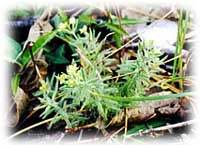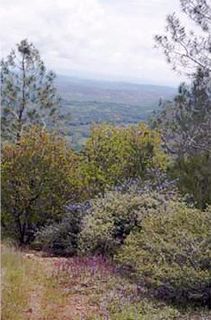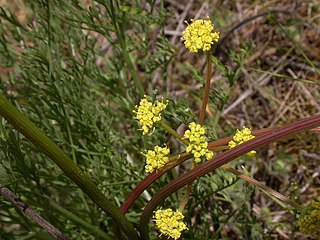
Fremontodendron, with the common names fremontia, flannelbush, and flannel bush, is a genus of three known species of shrubs native to the Southwestern United States and northwest Mexico.

Serpentine soil is an uncommon soil type produced by weathered ultramafic rock such as peridotite and its metamorphic derivatives such as serpentinite. More precisely, serpentine soil contains minerals of the serpentine subgroup, especially antigorite, lizardite, and chrysotile or white asbestos, all of which are commonly found in ultramafic rocks. The term "serpentine" is commonly used to refer to both the soil type and the mineral group which forms its parent materials.

Fremontodendron californicum, with the common names California flannelbush, California fremontia, and flannel bush, is a flowering shrub native to diverse habitats in southwestern North America.

Thlaspi, or pennycress, is a genus of herbs of temperate regions of the Eurasian continent. They occur in Central and South Europe, South-West Asia and two species are endemic to China. The Thlaspi has been proven to be a hyperaccumulator of heavy metals such as zinc and cadmium and therefore may be used in phytoremediation initiatives.
Kneeland Airport is a public airport operated by Humboldt County 10 miles (16 km) southeast of Eureka, California. Located on a mountain ridge at over 2,700 feet (820 m) above sea level, this airfield is used by general aviation aircraft, which sometimes seek an alternate airport when nearby low-lying airports are under fog. The airport has a California Dept. of Forestry (CDF) Helitack Station. Kneeland Airport is also used as an excellent sky watching location for the Humboldt Astronomers club.

The Tiburon paintbrush or Tiburon Indian paintbrush is an endangered taxon of flowering plant in the family Orobanchaceae. It is endemic to the San Francisco Bay Area in California in the United States, where it occurs in Marin, Napa, and Santa Clara Counties.

Festuca californica is a species of grass known by the common name California fescue.

Galium californicum is a species of flowering plant in the coffee family known by the common name California bedstraw.

Camissonia benitensis is a species of evening primrose known by the common names San Benito suncup and San Benito evening primrose. It is endemic to California, where its range includes far southern San Benito County, far western Fresno County, and far eastern Monterey County.

Ceanothus ferrisiae is a rare species of shrub in the family Rhamnaceae. Its common name is coyote ceanothus.

Pine Hill Ecological Reserve is a nature reserve of 403 acres (1.63 km2) located due east of Folsom Lake in the Sierra Nevada foothills, in El Dorado County, California. The reserve was established in 1979, and is managed by the California Department of Fish and Game.

Oenothera californica, known by the common name California evening primrose, is a species of flowering plant in the evening primrose family.

Orobanche californica, known by the common name California broomrape, is a species of broomrape. It is a parasitic plant growing attached to the roots of other plants, usually members of the Asteraceae.

Silene campanulata is a species of flowering plant in the family Caryophyllaceae known by the common names Red Mountain catchfly and bell catchfly. It may be a synonym of Silene greenei.

Clematis socialis is a rare species of flowering plant in the buttercup family known by the common name Alabama leather flower. It is native to the US states of Alabama and Georgia, where it is known from only five populations. The species is seriously threatened by habitat destruction. It is a federally listed endangered species.
Cranichis ricartii is a rare species of orchid known by the common name Puerto Rico helmet orchid. It is native to Puerto Rico, where it is known from three locations in one forest. The plant has also been seen in Guadeloupe. The plant's rarity is the main reason for its listing as an endangered species of the United States.

Echinocereus fendleri is a species of cactus known by the common names pinkflower hedgehog cactus and Fendler's hedgehog cactus. It is named in honor of Augustus Fendler.

Lomatium cookii is a rare species of flowering plant in the carrot family known by the common names Cook's lomatium and agate desertparsley. It is endemic to Oregon in the United States, where it grows in only two valleys. It is a federally listed endangered species.

Glaucocarpum is a monotypic plant genus containing the single species Glaucocarpum suffrutescens, a rare species of flowering plant in the mustard family known by the common names Uinta Basin waxfruit, waxfruit mustard, toad-flax cress, and shrubby reed-mustard. It is endemic to Utah in the United States, where it is known only from Duchesne and Uintah Counties. It is threatened by habitat degradation and destruction. It is federally listed as an endangered species of the United States.
Hastingsia bracteosa is a rare species of flowering plant in the agave subfamily of the asparagus family known by the common name large-flowered rushlily. It is endemic to Oregon in the United States, where it is limited to a twelve-mile stretch of the Illinois Valley in the southwestern part of the state.


















